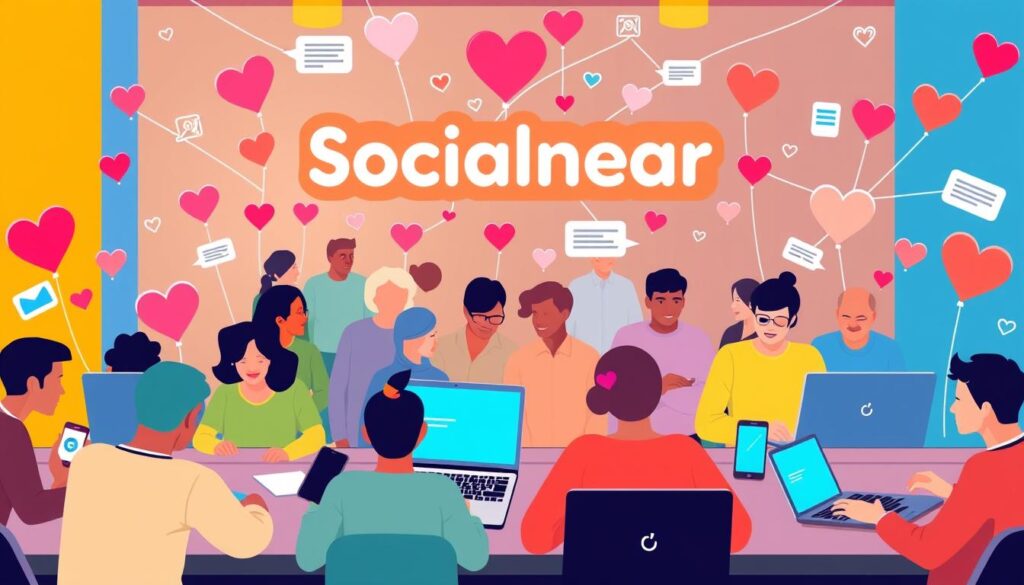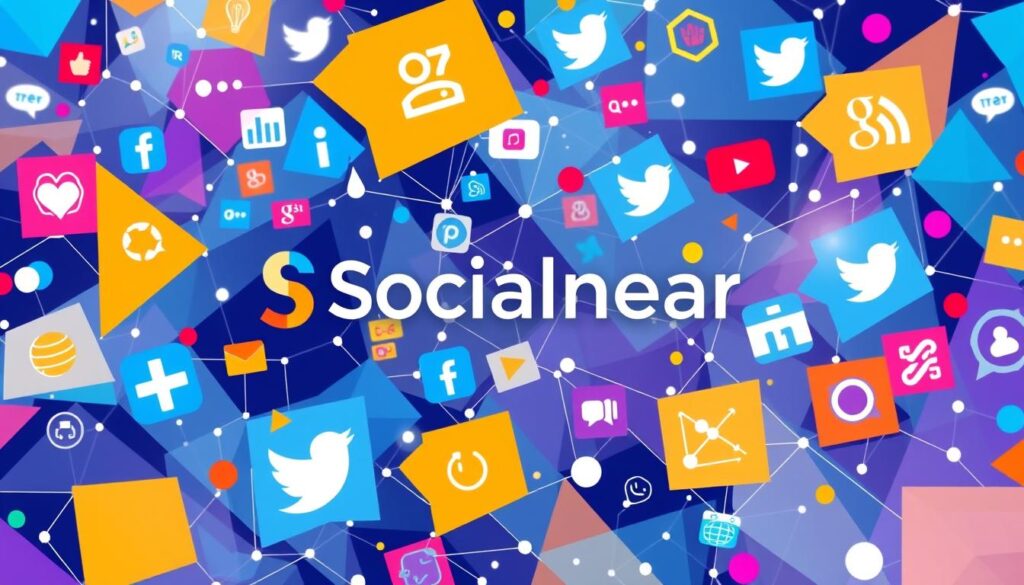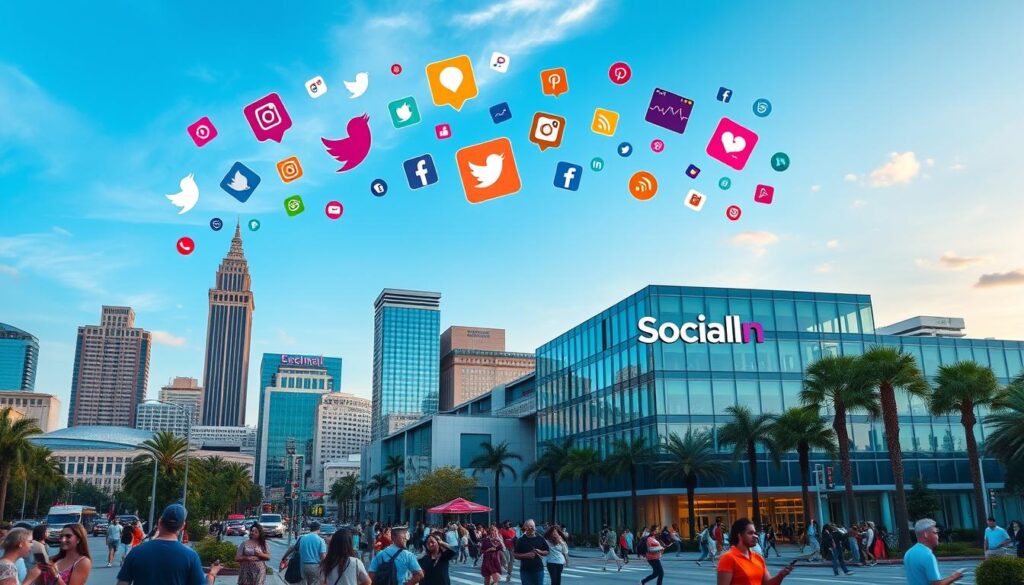In today’s fast-paced digital world, combining social media and content marketing is key for businesses. This guide will show you how to use social platforms and create content that grabs your audience’s attention. You’ll learn strategies and best practices to boost your brand and grow your business.
Discover how to make content that people want to share and talk about. This will help your brand reach more people and build real connections with your followers. You’ll learn about the importance of content in social media, how to use user-generated content, and how to measure your success. This guide will give you the tools and knowledge to succeed in the digital world.
Key Takeaways
- Explore the symbiotic relationship between social media and content marketing
- Craft compelling, shareable content that resonates with your target audience
- Leverage social platforms to enhance your brand’s reach and visibility
- Measure the success of your social media and content marketing strategies
- Stay agile and adaptable to changing trends and platform updates
Understanding the Relationship Between Social Media and Content Marketing
In today’s digital world, social media and content marketing go hand in hand. Quality content is crucial for social media success. It boosts engagement, increases reach, and helps meet your marketing goals.
The Role of Content in Social Media
Social media platforms need content that grabs users’ attention. This can be blog posts, graphics, or videos. The right content strategy helps you stand out online.
Enhancing Reach through Strategic Content
Creating content that matches your audience’s interests can expand your reach. Using SEO-optimized content makes you easier to find. Trying different content types helps find what works best with your followers.
User Engagement and Content Types
- Images and videos tend to get more engagement on social media.
- Content that makes people think, learn, or laugh can build stronger connections.
- Sharing user-generated content can make your brand seem more real and build a community.
Knowing what engagement metrics are important to your business helps improve your content strategy. This way, you can make the most of your social media presence.
“Content is the cornerstone of any successful social media strategy. It’s the key to capturing your audience’s attention and driving meaningful engagement.”
The Importance of a Clear Strategy
Creating a good social media and content marketing plan is key for businesses. It helps them connect with their audience and meet their online goals. By setting clear goals, knowing your audience, and choosing the right platforms, you can make a plan that works well.
Setting Goals and Objectives
First, set SMART goals for your social media and content marketing. These could be to increase brand awareness, get more leads, boost website visits, or drive sales. Use Key Performance Indicators (KPIs) to see how you’re doing and if your strategy is working.
Identifying Your Target Audience
Knowing who your audience is is very important. Use social media and content marketing to reach them. Look at their age, gender, location, and interests to make buyer personas. This way, you can make content that they’ll like and find on the platforms they use.
Choosing the Right Platforms
There are many social media platforms out there. Pick the ones that fit your brand, audience targeting, and goals. Think about who uses each platform, what kind of content they like, and what it can do. This helps you use your resources well and reach the right social media audience.
| Social Media Platform | Key Features | Target Audience |
|---|---|---|
| Diverse content, targeting options, paid advertising | Wide range of ages, interests | |
| Visual content, influencer marketing, Instagram Stories | Younger, visually-driven audience | |
| Professional networking, content sharing, job postings | Business professionals, industry leaders | |
| Real-time updates, hashtag trends, short-form content | Broad range of users, news and current events |
“A clear strategy is the foundation for successful social media and content marketing. It provides direction, focus, and measurable goals to guide your efforts.”
Content Creation Essentials
In the world of social media and content marketing, making engaging content is crucial. It’s about creating captivating copy and eye-catching visuals. This is how you drive user engagement and build a strong brand.
Crafting Compelling Copy
Words have a lot of power in social media content. Write copy that is short, friendly, and shows your brand’s personality. Use stories to connect with your audience and get them to act.
Visual Content: Images and Videos
Visual content is key to a good social media plan. Use high-quality images and videos that show what your brand is about. Try out different types like infographics and GIFs to keep people interested.
Leveraging User-Generated Content
- Use user-generated content (UGC) to boost your content strategy.
- Ask your audience to share their stories, photos, and reviews about your brand or products.
- Share the best UGC to build a community and show your customers’ loyalty.
By focusing on content creation, you can make a variety of engaging content. This content will connect with your audience and encourage them to share their own stories. Always keep improving, stay up-to-date with trends, and let your brand’s voice be heard in every piece of content.
Best Practices for Social Media Posting
Creating a strong social media presence is more than just posting. To grab your audience’s attention and boost engagement, follow these tips for 2024.
Timing and Frequency for Engagement
When it comes to posting, timing is everything. Studies show that posting at certain times can get more people to interact. Try posting during busy hours like mornings, lunch, and evenings to get more eyes on your social media content. Also, post regularly but don’t flood your followers’ feeds.
Hashtag Strategies for Greater Reach
Hashtags can help you reach more people. Use them wisely to get your content seen in searches and discussions. Mix popular, industry, and branded hashtags to attract new followers and connect with your audience. Keep an eye on how your hashtags and tweak your strategy to get the best results.
The Importance of Authenticity
Being real is key to lasting connections with your social media followers. Don’t post only to sell or look perfect. Share real, valuable content that shows your brand’s true self. This builds trust and loyalty, boosting your brand’s image and social media presence.
“The key to successful social media posting is finding the right balance between strategy and authenticity. It’s not just about timing and frequency, but about connecting with your audience in a genuine and meaningful way.”
| Optimal Posting Times | Frequency |
|---|---|
| 6-9 AM, 12-3 PM, 7-10 PM | 1-3 posts per day |
Analyzing Engagement Metrics
In the fast-paced world of digital marketing, engagement metrics are crucial. They show how your social media and content strategies are doing. By tracking these metrics, you learn how your audience interacts with your brand. This helps you improve your strategies for better results.
Key Performance Indicators to Track
There are key KPIs to watch for in engagement metrics. These include:
- Reach: The number of people who see your content
- Impressions: How many times your content is shown
- Engagement rate: How much of your audience interacts with your content
- Click-through rate: How many users click on your content compared to those who see it
- Share of voice: How visible your brand is compared to competitors
Tools for Social Media Analytics
Many tools can help you track and analyze your engagement metrics. Some top choices are:
| Tool | Key Features |
|---|---|
| Google Analytics | Comprehensive website and social media analytics |
| Sprout Social | Social media management and analytics platform |
| Hootsuite | Social media scheduling, monitoring, and reporting |
Adjusting Strategies Based on Data
By analyzing your engagement metrics, you learn what content works best. You also see where you can do better. Use this data to keep improving your strategies, content, and social media presence.
“Data-driven decision-making is the key to maximizing the impact of your social media and content marketing strategies.”
Content Distribution Techniques
Creating great content is just the start. To really make it count, you must learn how to share it well. This means using both paid and free methods, teaming up with others, and finding new ways to share what you already have. Check out this link for more on how to share your content.
Paid vs. Organic Reach
There’s a big debate about whether to use paid or free social media strategies. Paid ads can get your message out fast and target the right people. But free content builds trust and keeps people coming back. The best plan is to use both to reach more people and meet your goals.
Collaborations and Influencer Marketing
Working with other brands or influencers can really help your content reach more people. It lets you tap into their followers and gain their trust. Choosing the right influencer can greatly increase your brand’s visibility.
Repurposing Existing Content
- Give your top content a new life by sharing it in different ways.
- Turn a blog into social media graphics or a video.
- Make short tips or infographics from your content’s best parts.
- Share your most popular content again to reach more people.
Using a smart plan to share your content can grow your brand and connect with more people. This leads to better business results.
| Paid Reach | Organic Reach |
|---|---|
| Immediate visibility and targeted audience access | Fosters deeper engagement and long-term brand loyalty |
| Requires ongoing investment | Relies on building genuine connections and sharing valuable content |
| Can complement organic strategies | Provides sustainable growth over time |

“Effective content distribution is the key to unlocking your brand’s full potential on social media.”
Incorporating SEO into Content Marketing
In today’s digital world, combining content strategy and digital marketing is key. To boost your content marketing, using SEO is vital. This way, you can make your content more visible and reach more people.
Keyword Research and Implementation
Good content starts with solid keyword research. Knowing what your audience searches for helps you create content they’ll love. This approach not only helps you rank better but also makes your content valuable to readers.
Optimizing Content for Search Engines
After finding the right keywords, it’s time to use them in your content. Make sure your page titles, meta descriptions, headings, and text are optimized. Good optimization boosts your search engine ranking and makes your content better for users.
Balancing SEO with Audience Needs
SEO is important, but don’t forget about your audience. Your content should be good for search engines and valuable to readers. Focus on creating high-quality, informative, and attractive content to balance SEO and audience needs.
| Keyword Research | Content Optimization | Audience Engagement |
|---|---|---|
| Identify the most relevant and high-performing keywords for your niche. | Strategically incorporate keywords into your page titles, headings, and body text. | Prioritize the creation of content that resonates with your target audience and provides genuine value. |
| Leverage tools like Google Keyword Planner to uncover relevant search trends. | Optimize meta descriptions and alt text to improve search visibility. | Ensure your content is engaging, informative, and visually appealing. |
| Align your content strategy with the search intent of your audience. | Structure your content in a logical and user-friendly manner. | Foster a strong connection with your audience through consistent, valuable content. |
By blending SEO into your content strategy and digital marketing, you can boost both visibility and engagement. This approach helps you connect with your audience, build your brand, and meet your marketing goals.
“Striking the right balance between SEO and audience needs is the secret to long-term content marketing success.”
Building a Community Around Your Brand
In today’s digital world, having a strong brand community is key. It helps boost brand awareness and engagement. A brand community is where people who love your brand can talk to each other and to you. It helps you connect deeper with your audience, build loyalty, and make your marketing better.
Engaging with Followers and Customers
It’s important to talk to your followers and customers often and meaningfully. Reply to comments, ask questions, and start conversations. This shows you care about what they think. Share content made by your fans, show behind-the-scenes stuff, and talk about your customers’ experiences. This makes people feel like they belong.
Utilizing Groups and Forums
- Make online groups or forums for your community to meet, share ideas, and talk about your brand.
- Join in the talks, keep things in order, and let your community help run the group.
- Use these places to get feedback, solve problems, and get closer to your customers.
The Role of Live Events and Webinars
Live events and webinars are great for building a community. They let your audience meet your brand and each other live. Think about hosting interactive workshops, Q&A sessions, or special product previews to get closer to your community.
“Building a brand community is like nurturing a garden – it requires consistent care, attention, and a willingness to adapt to the needs of your audience.”
By using these methods, you can make a lively brand community. It becomes a place for your most loyal fans and supporters. This can increase brand awareness and engagement metrics. It makes your brand stronger and more impactful.

Staying Current with Trends
In the fast-paced world of social media and digital marketing, keeping up is key. It’s important to watch for changes in social media algorithms. Also, adapting to new tools and exploring new platforms is crucial for staying ahead.
Monitoring Changes in Social Media Algorithms
Social media platforms change their algorithms often. This is to improve user experience and how content is shown. Businesses need to keep an eye on these updates. Use analytics tools and talk to industry influencers to stay in the loop.
Adapting to New Features and Tools
New features and tools are always coming out. From short-form video content to augmented reality filters, businesses should try them out. Being quick to adapt will keep your brand fresh and interesting to your audience.
Embracing Emerging Platforms
New social media platforms keep popping up. While it might seem like a lot, trying out new platforms can help you reach more people. Keep an eye on upcoming social media apps and features to stay ahead and connect with your audience in new ways.
By being alert, flexible, and forward-thinking, businesses can thrive in the digital world. Keeping up with trends and innovations will help your brand engage your audience. It will also strengthen your online presence and drive growth over time.
Evaluating Overall Success and ROI
As you move forward in your social media and content marketing journey, it’s key to check how well you’re doing. Looking at the return on investment (ROI) gives you insights into your strategies’ success. It helps you make better choices for the future.
Measuring the Impact of Social Media on Sales
One important thing to watch is how your social media affects sales. Track conversions, leads, and revenue from your social media campaigns. This shows the financial wins of your content marketing. Use tools and analytics to see which platforms and content types work best.
Long-Term vs. Short-Term Benefits
Short-term wins, like more website visits or engagement, matter. But, don’t forget about the long-term benefits. Building brand awareness, thought leadership, and customer loyalty can greatly help your business. Look at both short-term and long-term success when measuring your efforts.
Continuous Improvement and Learning
Always aim to get better at social media and content marketing. Check your performance often, listen to your audience, and try new things. By always learning and adjusting, you can make your content marketing even better. This includes boosting brand awareness and smart content repurposing.
FAQ
What is the relationship between social media and content marketing?
Social media and content marketing go hand in hand. Good content helps social media succeed by reaching more people and getting them involved. It also helps spread your brand’s message far and wide.
How do I create a successful social media and content marketing strategy?
First, set clear goals and know who you’re talking to. Pick the best social media sites for your brand. Then, plan your content, use what your followers share, and stay true to your brand.
What are the best practices for social media posting?
Post at the right times and don’t overdo it. Use hashtags wisely and be real. Also, talk to your followers often to build strong bonds.
How do I measure the success of my social media and content marketing efforts?
Watch how people interact with your posts, how many see them, and if they buy from you. Use tools to understand your data and keep improving your plans.
What content distribution techniques should I consider?
Try both paid and free ways to share your content. Work with influencers and reuse your best stuff. This way, you can reach more people on different platforms.
How can I incorporate SEO into my content marketing strategy?
Find the right keywords, make your content easy to find, and keep it interesting. This way, more people will see and enjoy your content.
How do I build a strong community around my brand on social media?
Talk to your followers, join groups, and host events. This helps create real connections and a loyal fan base for your brand.
How can I stay up-to-date with the latest trends in social media and content marketing?
Keep an eye on algorithm changes, learn about new tools, and check out new platforms. This keeps you ahead and your strategies fresh.
How do I measure the overall success and ROI of my social media and content marketing efforts?
Look at how your efforts affect sales and balance short-term wins with long-term growth. Always look for ways to improve and get the most out of your efforts.




